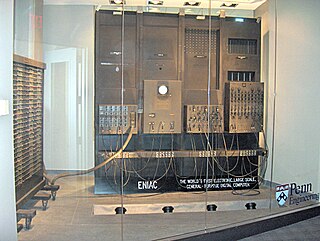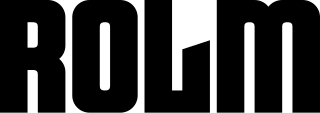
Computer science is the study of computation, information, and automation. Computer science spans theoretical disciplines to applied disciplines.

Electronics is a scientific and engineering discipline that studies and applies the principles of physics to design, create, and operate devices that manipulate electrons and other electrically charged particles. It is a subfield of physics and electrical engineering which uses active devices such as transistors, diodes, and integrated circuits to control and amplify the flow of electric current and to convert it from one form to another, such as from alternating current (AC) to direct current (DC) or from analog signals to digital signals.

The history of computing hardware spans the developments from early devices used for simple calculations to today's complex computers, encompassing advancements in both analog and digital technology.

ENIAC was the first programmable, electronic, general-purpose digital computer, completed in 1945. Other computers had some of these features, but ENIAC was the first to have them all. It was Turing-complete and able to solve "a large class of numerical problems" through reprogramming.

Whirlwind I was a Cold War-era vacuum-tube computer developed by the MIT Servomechanisms Laboratory for the U.S. Navy. Operational in 1951, it was among the first digital electronic computers that operated in real-time for output, and the first that was not simply an electronic replacement of older mechanical systems.

The IBM 604 Electronic Calculating Punch was the world's first mass-produced electronic calculator along with its predecessor the IBM 603. It was an electronic unit record machine that could perform multiple calculations, including division. It was invented and developed by Ralph Palmer, Jerrier Haddad and Byron Phelps. It was introduced by IBM in 1948.

UNIVAC was a line of electronic digital stored-program computers starting with the products of the Eckert–Mauchly Computer Corporation. Later the name was applied to a division of the Remington Rand company and successor organizations.

The IBM 7090 is a second-generation transistorized version of the earlier IBM 709 vacuum tube mainframe computer that was designed for "large-scale scientific and technological applications". The 7090 is the fourth member of the IBM 700/7000 series scientific computers. The first 7090 installation was in December 1959. In 1960, a typical system sold for $2.9 million or could be rented for $63,500 a month.
A stored-program computer is a computer that stores program instructions in electronically, electromagnetically, or optically accessible memory. This contrasts with systems that stored the program instructions with plugboards or similar mechanisms.

The UNIVAC 1103 or ERA 1103, a successor to the UNIVAC 1101, is a computer system designed by Engineering Research Associates and built by the Remington Rand corporation in October 1953. It was the first computer for which Seymour Cray was credited with design work.

The IBM Selective Sequence Electronic Calculator (SSEC) was an electromechanical computer built by IBM. Its design was started in late 1944 and it operated from January 1948 to August 1952. It had many of the features of a stored-program computer, and was the first operational machine able to treat its instructions as data, but it was not fully electronic. Although the SSEC proved useful for several high-profile applications, it soon became obsolete. As the last large electromechanical computer ever built, its greatest success was the publicity it provided for IBM.

ROLM Corporation was a technology company founded in Silicon Valley in 1969. IBM Corp. partnered with the company, and ROLM Mil-Spec was sold to Loral Corporation and later to Lockheed Martin in 1996 as Tactical Defense Systems. IBM's ROLM division was later half sold to Siemens AG in 1989, whereupon the manufacturing and development became wholly owned by Siemens and called ROLM Systems, while marketing and service became a joint venture of IBM with Siemens, called ROLM Company. After nearly 30 years, phone products with the name "Rolm" were discontinued in the late 1990s, as sales dropped in markets dominated by new technology with other products or other companies.

A transistor computer, now often called a second-generation computer, is a computer which uses discrete transistors instead of vacuum tubes. The first generation of electronic computers used vacuum tubes, which generated large amounts of heat, were bulky and unreliable. A second-generation computer, through the late 1950s and 1960s featured circuit boards filled with individual transistors and magnetic-core memory. These machines remained the mainstream design into the late 1960s, when integrated circuits started appearing and led to the third-generation computer.
Nathaniel Rochester was the chief architect of the IBM 701, the first mass produced scientific computer, and of the prototype of its first commercial version, the IBM 702. He wrote the first assembler and participated in the founding of the field of artificial intelligence.

The Manchester computers were an innovative series of stored-program electronic computers developed during the 30-year period between 1947 and 1977 by a small team at the University of Manchester, under the leadership of Tom Kilburn. They included the world's first stored-program computer, the world's first transistorised computer, and what was the world's fastest computer at the time of its inauguration in 1962.

In computer science and computer engineering, computer architecture is a description of the structure of a computer system made from component parts. It can sometimes be a high-level description that ignores details of the implementation. At a more detailed level, the description may include the instruction set architecture design, microarchitecture design, logic design, and implementation.
Bruce Gilchrist is considered one of the notable figures in modern computing history.
Information technology (IT) is a set of related fields that encompass computer systems, software, programming languages, data and information processing, and storage. IT forms part of information and communications technology (ICT). An information technology system is generally an information system, a communications system, or, more specifically speaking, a computer system — including all hardware, software, and peripheral equipment — operated by a limited group of IT users, and an IT project usually refers to the commissioning and implementation of an IT system. IT systems play a vital role in facilitating efficient data management, enhancing communication networks, and supporting organizational processes across various industries. Successful IT projects require meticulous planning and ongoing maintenance to ensure optimal functionality and alignment with organizational objectives.

A vacuum-tube computer, now termed a first-generation computer, is a computer that uses vacuum tubes for logic circuitry. While the history of mechanical aids to computation goes back centuries, if not millennia, the history of vacuum tube computers is confined to the middle of the 20th century. Lee De Forest invented the triode in 1906. The first example of using vacuum tubes for computation, the Atanasoff–Berry computer, was demonstrated in 1939. Vacuum-tube computers were initially one-of-a-kind designs, but commercial models were introduced in the 1950s and sold in volumes ranging from single digits to thousands of units. By the early 1960s vacuum tube computers were obsolete, superseded by second-generation transistorized computers.

The 5965 is a miniature twin triode vacuum tube. One of its manufacturers, Sylvania, states that it was “designed for use in high-speed digital computers”.

















